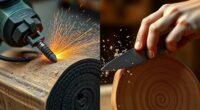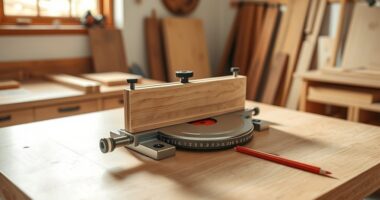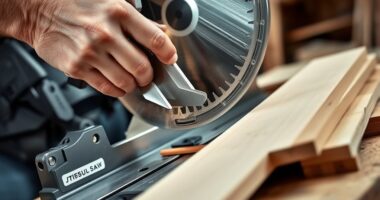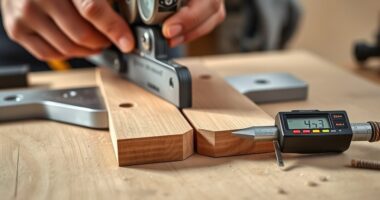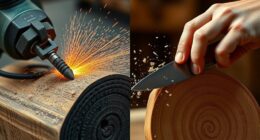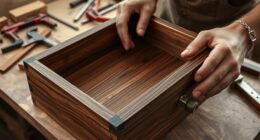Before using an angle grinder with a carving disc, make certain you wear safety goggles, gloves, ear protection, and a dust mask, and inspect the disc for damage. Keep the workspace clear of hazards, secure your material firmly, and hold the grinder at a 15 to 30-degree angle to the surface. Always use the guard and let the tool do the work without forcing it. Following proper techniques helps prevent accidents—continue to explore for detailed safety steps.
Key Takeaways
- Always wear safety gear and ensure the workspace is clear before using the carving disc.
- Inspect the disc for damage and secure the material firmly to prevent shifting during operation.
- Hold the grinder at a 15 to 30-degree angle and let the disc do the work without forcing it.
- Keep the guard in place, and turn off the grinder and wait for the disc to stop before setting down.
- Regularly check and maintain the disc and tool, cleaning after use and storing safely to ensure optimal safety.

Are you looking for a precise and efficient way to carve through tough materials? An angle grinder carving disc can be your best tool for tasks like shaping stone, cutting metal, or removing excess material from various surfaces. However, to use it effectively and safely, you need to understand when and how to handle it properly. First, always prioritize safety precautions before starting any project. Wear appropriate personal protective equipment, including safety goggles, gloves, ear protection, and a dust mask. The spinning disc can produce sparks, debris, and loud noise, so protecting yourself is essential. Make sure your workspace is clear of bystanders and flammable materials. Secure the material you’re working on firmly, so it doesn’t shift unexpectedly during operation. Before you begin, inspect the carving disc for any cracks, chips, or signs of wear. Using a damaged disc can lead to dangerous breakage and injury. Proper maintenance tips include regularly checking the disc for signs of dullness or damage and replacing it when necessary. Keep your angle grinder’s guard in place; it helps contain sparks and debris, reducing risk. Also, ensure your grinder is in good working condition with a secure grip on the power cord or battery, depending on your model. When it’s time to start, hold the grinder firmly with both hands, maintaining control at all times. Engage the disc at a 15 to 30-degree angle to the surface for effective cutting or carving, but avoid forcing the tool—let the disc do the work. Keep the tool moving smoothly along the material to prevent overheating and uneven cuts. Always be aware of the disc’s rotation and never try to force the tool into a cut; this can cause the disc to bind or shatter. When finished, turn off the grinder and wait for the disc to come to a complete stop before setting it down. Proper maintenance after use involves cleaning the tool and storing it in a safe, dry place. Periodic checks on the cord, switch, and guard ensure the tool remains safe for future use. Using an angle grinder carving disc safely isn’t just about protecting yourself; it’s also about preserving your equipment and ensuring precise results. Follow these safety precautions and maintenance tips diligently, and you’ll be able to carve through tough materials efficiently while minimizing risks. Remember, patience and careful handling are key to achieving professional-quality results without accidents or damage. Additionally, understanding the importance of digital literacy can help users stay informed about safety updates and best practices for power tools.
Frequently Asked Questions
Can I Use the Carving Disc on Metal Surfaces?
You can use a carving disc on metal surfaces, but you need to check its metal compatibility first. Not all carving discs are designed for metal, as some have limitations that make them unsuitable for such use. Always verify the disc’s specifications and confirm it’s rated for metal cutting or carving. Using the right disc prevents damage and ensures safety, so don’t ignore the carving disc limitations when working with metal.
What Are the Signs of Disc Wear or Damage?
Imagine you’re carving metal and suddenly feel abnormal vibrations—that’s a red flag. Signs of disc wear or damage include disc surface cracks, which weaken its structure, or excessive wobbling during use. If you notice these issues, stop immediately. Regularly inspect your disc for cracks, warping, or chips. Using a damaged disc risks breakage and injury, so always replace worn or cracked discs before continuing your project.
How Do I Choose the Right Disc for Different Materials?
When choosing a disc for different materials, you need to take into account material compatibility to ensure safety and effectiveness. Use disc selection tips like matching the disc type to the material you’re working on—metal, stone, or concrete. Check the disc’s specifications for maximum RPM and intended use. Always select a disc designed for your specific task, and confirm it fits your angle grinder before starting your project.
Is It Safe to Use a Carving Disc Without Eye Protection?
Ignoring eye safety while using a carving disc is like leaving your shield at home in a battlefield. You should always wear protective gear, especially eye protection, to prevent debris and sparks from hitting your eyes. Even small particles can cause serious damage. So, never skip eye safety; always wear proper protective gear. It’s a simple step that keeps your vision safe and your project on track.
How Do I Maintain and Store the Carving Disc Properly?
To maintain your carving disc, regularly clean it with a wire brush or damp cloth to remove debris and prevent rust. Check for signs of wear or damage before each use. Store it in a dry, cool place, ideally in a protective case or on a dedicated shelf to avoid accidental damage. Follow proper storage tips like keeping it away from moisture and extreme temperatures to prolong its lifespan and ensure safety.
Conclusion
Using an angle grinder carving disc is like wielding a master’s chisel—powerful but requiring respect. Always follow safety guidelines, wear protective gear, and choose the right disc for your material. When used carefully, it transforms rough cuts into smooth masterpieces, turning a challenging task into a manageable craft. Think of it as your trusted tool on a creative journey—sharp, precise, and ready to bring your vision to life safely.

